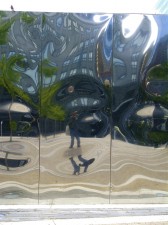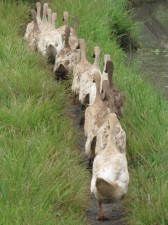Hidden treasure
Marion Milner had always wanted to be an artist. But the biologist, and later psychoanalyst, became frustrated with the conventional drawing techniques she had learned. So she began to experiment with ‘free drawing’; letting the hand and eye do exactly what pleased them. In doing so, her ‘common sense’ scientist’s mind, with its commitment to definite boundaries and sharp lines, had to give way to a more diffuse and abstract symbolic language. Milner’s journal of discovery, On Not Being Able to Paint (1950), is now a forgotten resource on creativity and the inhibitions we place in its way. An avalanche of research has succeeded her and now permeates many fields, particularly neuroscience and neuropsychology. But Milner’s journal still retains a fresh spark of insight and hope – a creative aliveness to the challenge of integrating the inner and outer worlds of human experience.

Photo by Howard Gwynne
I first heard of Milner many years ago. She was one of the fabled ‘middle group’, a cluster of independently minded, mid twentieth century British psychoanalysts, who had detached themselves from the other two dominant camps led by Anna Freud and Melanie Klein. This group attracted prominent and innovative thinkers, such as DW Winnicott, Ronald Fairbairn, John Bowlby and RD Laing.
While I had heard her name, I had never read any of Milner’s books and knew very little about her. One day I was visiting an old friend who was in the process of weeding her extensive book collection. There were boxes of redundant books strewn across the floor and big gaps in the bookshelves where they had once lived. Milner’s book was still standing, as if emerging from a long sleep. It caught my eye and I asked if I could borrow it, little knowing that it would contain a hidden treasure.
In her candid and somewhat circuitous way, Milner documents the psychological knots, discoveries and dis-entanglements that accompany her creative journey; a visual journey in which her various paintings are interrogated for messages emanating from her unconscious. If it were just that it would soon get boring, but Milner generates a parallel dialogue, one in which the barriers to free creative expression are unpacked and seen to be inextricably linked to the hard-won (but in her mind, overrated) process of separation from the mother that signals and shapes our perception of ‘objective’ and ‘subjective’ worlds. The denial of spontaneity and instinctual bodily expression that this split gives birth to in Western human consciousness, is a convention that Milner attributes to our tendency to be “seduced by objectivity.” (Milner 1950, p.117)
But stepping outside conventional realities and plunging into the changing and sometimes boundary-less world of one’s imagination, can be a fearful enterprise for many.
Certainly it seemed that as long as one is content to live amongst the accepted realities of the common sense world, the fear of losing one’s hold on the solid earth may remain unrecognised; but that as soon as one tries to use one’s imagination, to see with the inner as well as the outer eye, then it may have to be faced. (Milner:p.25)
It wasn’t order per se that Milner objected to, but imposed order, the “forcing of human experience to fit a dictatorial mindset.” She encouraged herself and others to allow space for a “spontaneous ordering”, what we might call today an emergent order. Intention and will are necessary for creativity, they help “frame the empty space” and focus the attention needed to allow new knowledge to emerge. But if we are subject to the tyranny of what we would these days call left-brain thinking, then all we can do is replicate the past because there will be no free space for anything new to arise.
Long before Roger Sperry pinned down the distinct and complementary functions of the brain’s right and left hemispheres; long before the publishing success of books like Drawing on the Right Side of the Brain or The Artist’s Way; shortly before second wave feminism had mounted its scathing critique of the mind-body split that suffused Western thinking; and predating the birth of chaos and complexity thinking in science – Marion Milner explored and articulated the need for a respectful and active relationship between the dualities of order and spontaneity, doing and dreaming.
It is through the interplay of these different modalities that true originality can be forged:
Obviously the foreboding of those who fear planning, that all spontaneous endeavour and creativity will be stunted, is well founded, if the planners fail to understand their true function….of providing a secure frame for the free activities and tried to dictate the activities themselves, then there would certainly be sterility and chaos. But also the planners are right in their fear of chaos and its destructive results, in their realisation that without a definite frame human activity can spend itself in a disastrous dissipation of energy and failure of the opposing creative forces ever to confront each other. (P.105)
 Today we are exhorted to be creative and innovative. Innovation will drive business success and make us individually happy. Maybe it will even solve our global dilemmas. There are models, courses and case studies that will help us, but few of them address the fear of being catapulted into chaos and cast adrift from the solidity of our fixed sense of self that Milner so brilliantly describes. On Not Being Able to Paint was first published in 1950 under a pseudonym. What did Milner fear by not using her own name? Maybe she was too radical for the times – too raw and unconventional? Maybe her insights still are?
Today we are exhorted to be creative and innovative. Innovation will drive business success and make us individually happy. Maybe it will even solve our global dilemmas. There are models, courses and case studies that will help us, but few of them address the fear of being catapulted into chaos and cast adrift from the solidity of our fixed sense of self that Milner so brilliantly describes. On Not Being Able to Paint was first published in 1950 under a pseudonym. What did Milner fear by not using her own name? Maybe she was too radical for the times – too raw and unconventional? Maybe her insights still are?
Milner died in 1998 at the grand old age of 98! A lovely obituary appeared in The Independent written by her friend, Michael Brierly. He concluded:
Milner underlined the need to imbue the common-sense world with one’s personal sense of meaning. She described this process as the alchemy which transmutes base metal into gold. This requires a sacrifice of the old self and a plunge into emptiness, from which one develops a trust that, out of the unconscious, something new and valuable can grow.
1. Milner, Marion (1950) On Not Being Able to Paint, H.E.B. Paperback, London (1971 edition)
2. Brierly, Michael (1998), Obituary: Marion Milner – Arts & Entertainment – The Independent, 10 June 1998



